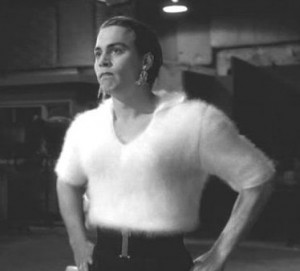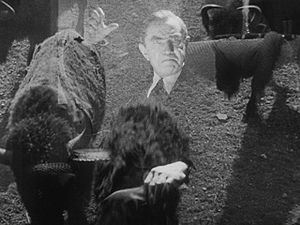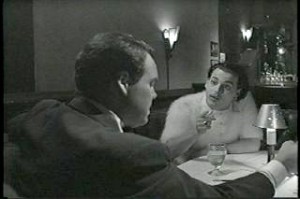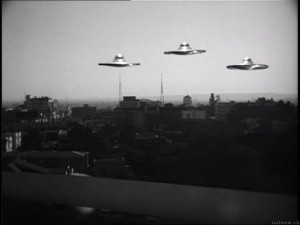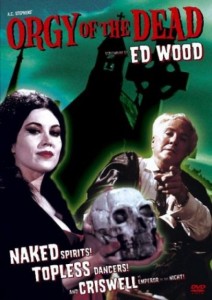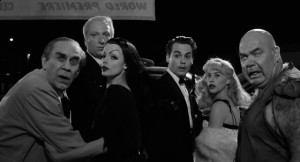100 Film Favorites – #14: Ed Wood
(Tim Burton, 1994)
“Cut! That was PERFECT!”
Double Burton, all the way across the sky. What does this mean? While Zemeckis and Spielberg have more entries scattered throughout the Countdown, Tim Burton might have the highest concentration of list-makers this close to the end (there’s another still to come). Maybe it’s the off-kilter stylistic elements he borrows from German Expressionism, or his persona as the “weird director,” at least among high-profile commercial filmmakers. Whatever the reason, many among Burton’s cavalcade of quirky films appeal to me greatly. It’s disappointing that his more recent films have often been remakes (even of his own films, as with Frankenweenie). While this approach may be both easy and bankable, it does a disservice to Burton’s creative genius. His earlier work demonstrates a passion for “doing something different” and original, and as such features some bizarrely likable characters in surreal, memorable situations. It would be great to see a return to this tradition (Big Fish and Corpse Bride get close) – the world needs another Edward Scissorhands, Pee-Wee’s Big Adventure, or Ed Wood.
Today’s selection is a biopic of, fittingly enough, filmmaker Ed Wood, who has notoriously been proclaimed the “Worst Director of All time” by many critics since the 80s, when his 1950s “B-movies” were rediscovered. Wood’s films feature stilted dialogue, shoddy production values, and a sense that no more than three people on set at any given time knew what they were doing. And yet, as Burton recollects, the films showcase a “surreal sincerity…a weirdly heartfelt feeling.” With every shambling mutant and pie-pan flying saucer, you get the sense that Wood believed wholeheartedly in his work, despite its many technical shortcomings.
The film opens with Wood (played by Burton staple Johnny Depp) watching from the wings at the opening performance of one of his plays. While the amateur actors stumble through the awkward dialogue, Wood passionately mouths along with every word, his eyes alight with artistic fervor. When an abysmal review appears in the paper the following day, Wood encourages his actors, including girlfriend Dolores Fuller (Sarah Jessica Parker) to look on the bright side (the critic praises the military uniforms in the production as “very realistic,” to which an overjoyed Wood remarks that he’s “seen reviews where they don’t even mention the costumes”). Ed insists that together, they are all doing quality work.
Ed’s dream is to break into the film industry (he works hauling props on the Universal Studios backlot). He sees himself as another Orson Welles, able to write, direct, produce, and act. One day, as he carts potted palm trees through a desert set (and wonders how and where the studio acquired real camels), two events occur which set Wood on the road to…ahem…”stardom.” First, he hears that “Christine” Jorgensen, the first person to undergo a male-female sex-change operation, has optioned the rights for her life story to be made into a movie. Wood reports to the office of Studio Classics, a low-budget producer of exploitation films, where he claims that he would be the perfect candidate to direct the film. When asked why, Ed discloses that he is a transvestite, and frequently enjoys wearing women’s clothing (particularly angora sweaters). Producer George Weiss dismisses this as irrelevant to the sex-change story and shoos Wood away.
But later that day, Ed encounters Dracula star Bela Lugosi (Martin Landau). Lugosi is “trying out coffins” at a funeral parlor, as he “plans on dying soon.” Once a relatively high-profile horror star, the elderly Lugosi now lives in obscurity and poverty, and suffers from an extreme addiction to morphine. Wood’s unfaltering optimism begins to boost the faded star’s spirit, and Ed and Bela discuss the possibility of working together.
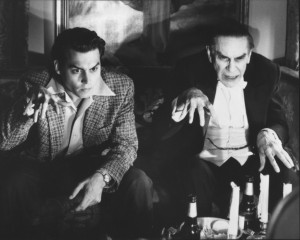
The friendship between Wood and Lugosit is one of the quirkiest and most charming parts of this true story.
Ecstatic, Wood returns to Weiss with the news that he has found “the one thing that if you put it in a movie it guarantees you’ll make money” (Weiss guesses “tits”). No, says Wood…a star! Wood has found such a star in Bela Lugosi, who is willing to star in the “Jorgensen picture” if Wood is signed to direct. Needing to get a film made (as he’s already paid to print a poster and book theaters in Oklahoma), Weiss signs Wood to the film.
Wood more or less discards the assigned premise, and instead of I Changed My Sex! (the title featured on Weiss’ poster) makes Glen or Glenda?, an autobiographical plea for wider acceptance of transvestism. The supremely strange film, interspersed throughout with shots of narrator Bela Lugosi screaming “PULL THE STRING!” while stock footage buffalo stampede across the screen, is (surprisingly) a flop, with the few critics who actually see it declaring it the “worst movie they’ve ever seen.”
Unable to secure backing from even the smallest studios, Ed decides to raise funds for his next project independently. To drum up financial support, Wood has Lugosi make an appearance on a Sid Caesar-style variety show, where they meet The Amazing Criswell, a television psychic who delivers outlandish prognostications (he predicts millions of people will live in Martian colonies by the end of the 70s). Criswell gives the naive Wood some advice: Success in show business relies on a bit of humbug. “If you look good, and you speak well, people will swallow anything.”
Wood therefore arranges a series of “backers’ galas,” inviting wealthy investors to a flashy club for a meet-and-greet with the cast. Ed promises that Bride of the Atom, his upcoming project, will be not only a hair-raising horror picture, but also a stirring romance. At one of the galas, Ed meets Vampira, one of the first “horror hosts,” who showcases old horror films on late-night local television. He implores her to join the cast of Bride, but she declines. Fundraising efforts continue to fall through until Ed approaches a rich cattle rancher. The cowboy offers to pay for the movie, provided it end with “a big explosion” and star his slow-witted son in the leading male role. Happy to have his money, Wood agrees, and soon filming on the newly-retitled Bride of the Monster is finally completed.
Despite finishing the project, Ed runs into some dark times, as Dolores breaks up with him over the issue of his transvestism, and Bela’s drug use worsens. Wood checks Bela into a rehabilitation center (making him “the first celebrity to check into rehab”), where Ed meets a young woman named Kathy O’Hara. Though Lugosi is kicked out of the clinic when his lack of insurance is revealed, Ed and Kathy begin a relationship.
Ed begins filming yet another project with Lugosi, capturing a small amount of silent footage outside the old star’s home. However, Lugosi dies before any significant progress is made. Wood approaches the leaders of a large church, and convinces them that funding a film in “a tested genre, like horror” will prove massively profitable, and provide the church with the funds necessary to produce a series of cinematic shorts on each of the 12 apostles. The church agrees to fund “Grave-Robbers from Outer Space,” provided Ed and his friends (including Criswell, Swedish wrestler Tor Johnson, and the flamboyantly gay “Bunny” Breckinridge) all get baptized first. Vampira is also part of the cast now, as the cancellation of her show has left her scrounging for work.
The church leaders grow wary of the film’s “sacrilegious” subject matter (alien invaders resurrect the dead as zombies), and protest Wood’s slipshod filmmaking method, which typically consists of capturing a single take of a shot, followed by Wood happily shouting “Cut! That was perfect!” The church leaders are further agitated when Wood arrives on set wearing his angora sweater. Fed up with the judgmental atmosphere, Ed walks off the set and heads to the nearest bar. There, he encounters his idol, Orson Welles. Welles, himself struggling with an interminable film project (an adaptation of Don Quixote which ultimately was never finished), Welles assures Wood that “visions are worth fighting for.”
Wood returns to the set. He will finish the film, he declares, but it will be done HIS way, without producer interference. Some months later, the retitled Plan 9 from Outer Space premieres in theaters. “This is it,” he says, as the pie-pan saucers zip across the screen. “This is the one they’ll remember me for.” Ed asks Kathy to marry him, and though the pouring rain has nearly filled his open convertible, the two lovebirds slosh into the car and motor off toward Las Vegas (“It’s only about a five-hour drive!”) to be wed.
A lot of films get described as “feel-good movies.” Well, this is one that always makes me actually feel good. Depp’s Ed Wood buzzes with unbridled optimism, and the bright-eyed (and often quite clever) way in which he rebounds from his various setbacks makes him a very likeable character, even if, as Dolores opines late in the film, he’s “wasting his life making shit and nobody cares.” In truth, the real Wood was less of a naive, kind-hearted dreamer (following Plan 9, most of his productions consisted of vaguely horror-themed softcore pornography).
Nevertheless, Burton and the screenwriters, who based the film on Wood’s own account of his escapades (as described in a series of letters) assert that the essence of the film is historically accurate: Wood sincerely saw himself as a legitimate filmmaker akin to Orson Welles, and regarded all he made as a genuine contribution to the field of motion picture artistry. Whatever its historical inaccuracies may be, Ed Wood is a charming film detailing a chapter of cinema history that’s right up my alley.
The fact that the film was made at all is somewhat surprising, given the relative obscurity of its subject matter and the growing acclaim and popularity of director Burton. Before its production, screenwriters Scott Alexander and Larry Karaszewski, who had devised the film’s concept while in college, noted that Ed Wood is remarkable solely for the fact that “there would be no one on the planet Earth who would make this movie or want to make this movie, because these aren’t the sort of movies that are made.” But Burton was intrigued, and did step up to make the film. Though originally in development at Columbia, that studio dropped the film when Burton insisted it had to be shot in black-and-white. Disney, Burton’s old employer, picked up the film and released it, black-and-white intact, under the Touchstone label.
Though produced for a modest budget of $18 million, the film grossed only about $5 million in theaters. Despite being a “flop,” the film received considerable critical praise. And at the 1994 Academy Awards, Martin Landau took home the Oscar for Best Supporting Actor for his role as Bela Lugosi (the film also won “Best Makeup” for Landau’s transformation into Lugosi…and also probably George “The Animal” Steele’s into Tor Johnson, which is likewise pretty uncanny).
As a final note on this gargantuan post, I also wanted to give kudos to the great casting. In addition to Depp and Landau, the film features memorable performances by Bill Murray (as Bunny Breckinridge), Jeffrey Jones as Criswell, and Lisa Marie as Vampira. It’s nice to think that all of these larger-than-life characters really lived, and that even though they “made shit,” they have gained an immortality of sorts. Bad movies will always have their place in film history, and Edward D. Wood, Jr. sits on top of the crap-heap, reigning forever as the king of schlock. Even at his most optimistic, I doubt the real Wood ever expected he’d one day be played by a major movie star, the subject of an Oscar-winning biopic.
Now the real question is, who’s going to star in the 2040 cult classic Tommy Wiseau?
—
Brian Terrill is the host of television show Count Gauntly’s Horrors from the Public Domain. You can keep up with Brian’s 100 Film Favorites countdown here.




